Lentils are a key food in the Mediterranean diet and have been a staple in Mediterranean cuisine for thousands of years. They are rich in protein, fiber, and essential nutrients, making them an important plant-based protein source in the diet, especially in regions where meat was historically less accessible.
History of Lentils
Lentils have been cultivated in the Mediterranean region for over 8,000 years, dating back to ancient times. Archaeological evidence shows that lentils were a significant part of the diet in ancient civilizations like the Egyptians, Greeks, and Romans.
They were highly valued for their nutritional content and ease of cultivation in the Mediterranean’s semi-arid climate.
Even today, lentils are used in various traditional dishes across the Mediterranean, such as Greek lentil soup (fakes), Italian lentil stews, and Middle Eastern lentil salads.
Lentils are not only locally cultivated but have been a cornerstone of the region’s cuisine for centuries, contributing to the health benefits associated with the Mediterranean diet.
Lentils support Weight Loss
Lentils won’t make you fat, as they’re low in calories, promote satiety, and increase energy metabolism, due to their high protein and fiber content. However, high portion sizes, bad meal timing, certain cooking recipes with fattening ingredients or eating lentils with high-calorie condiments can make you fat.
They have a few Calories
We gain weight when we consume more calories than we burn. Lentils won’t make you gain weight, as they’re pretty low in calories.
Cooked lentils have only 114 calories per 100g. A serving of lentils has up to 230 calories, which is less than 12% of the total calorie intake on a 2,000-calorie diet.[1]
Lentils are the beans with the fewest calories, second only to fava beans!
Promote satiety
Actually, lentils are good for weight loss, as they keep us full for a long time. Foods high in water, fiber, and protein are the most filling. Lentils are high in fiber and protein. Also, a cup has about 140 grams of water![2]
Fiber
Cooked lentils contain 7.9 grams of fiber per 100g. A cup contains 15.6 grams of fiber which is about 55% of the recommended daily intake.
All lentil varieties (red, green, yellow, orange, brown or black) have a similar fiber content. The exact fiber content may vary depending on many factors such as growing conditions, processing, and cooking methods.
Fiber deficiency has been associated with an increased risk of obesity.
Protein
Actually, lentils are great plant-based sources of protein. Their protein content ranges between 20.6% and 31.4%. It depends on many factors, like the lentil variety, processing methods, and cultivation region.[3]
Most common lentil varieties, such as brown, green, red, yellow, black beluga, and Puy, have a similar protein content.
Green lentils have the best amino acid profile than most common lentil varieties. On the other hand, red split lentils are more bioavailable than green lentils, but lack of many essential amino acids.[4]
| green lentils, cooked g/100g | split red lentils, cooked g/100g | |
| Histidine | 0,26 | 0,29 |
| Isoleucine | 0,37 | 0,43 |
| Leucine | 0,78 | 0,91 |
| Lysine | 0,78 | 0,81 |
| Methionine | 0,08 | 0,08 |
| Phenylalanine | 0,51 | 0,60 |
| Threonine | 0,41 | 0,45 |
| Tryptophan | 0,08 | 0,10 |
| Valine | 0,42 | 0,50 |
A serving provides up to 18 grams of protein!
Lentils aren’t a complete protein, though. Although they’re rich in many essential amino acids, such as leucine, lysine, threonine, and phenylalanine, lentils are deficient in the sulfur-containing essential amino acids methionine and cysteine.[5]
We have to eat lentils with other foods that contain the missing essential amino acids for a high-quality protein source.
Although raw lentils are about 25% protein, most lentil varieties don’t contain adequate amounts of methionine, which is an essential amino acid.
Combine lentils with rice or cereals for Complete Protein
Combining lentils with rice and whole-grain bread creates a complete protein. Lentils are high in lysine. On the contrary, rice, wheat, and most cereals don’t contain adequate amounts of lysine.
| brown rice, cooked g/100g | wheat bread g/100g | |
| Histidine | 0,07 | 0,22 |
| Isoleucine | 0,11 | 0,14 |
| Leucine | 0,21 | 0,33 |
| Lysine | 0,10 | 0,18 |
| Methionine | 0,06 | 0,07 |
| Phenylalanine | 0,13 | 0,34 |
| Threonine | 0,10 | 0,18 |
| Tryptophan | 0,03 | 0,16 |
| Valine | 0,15 | 0,07 |
Besides lentils, you could consume other beans, such as chickpeas and fava beans with rice or whole wheat bread to have a meal with high-quality plant-based protein.

Also, we should combine lentils with foods high in methionine to make a complete and high-quality protein. Most people need about 10 mg of methionine per kilogram of body weight. Therefore, a 70 kg person requires about 0.7 grams of methionine a day.[8]
Plant-based foods rich in methionine are:[9]
- pumpkin seeds (2.34 g per 100g)
- sesame seeds (1.6 g)
- Brazil nuts (1.1 g)
- hemp seeds (0.9 g)
- soy protein (0.8 g)
- chia seeds (0.6 g)
- oats (0.3 g)
- peanuts (0.3 g)
- buckwheat (0.29 g)
- chickpeas (0.25 g)
Hence, eating bread with sesame or pumpkin seeds with lentils could skyrocket the nutritional value of your meal. Certainly, you could be creative and cook lentils with these seeds. Just 1 tbsp of pumpkin seeds contains 0.17 grams of methionine!
Better cook lentils with chia seeds, instead of rice. They’re particularly high in methionine as well. Also, chia seeds are a complete protein! They contain all 9 essential amino acids.
All animal foods are complete protein. You can eat them with lentils for a healthy protein-rich meal.
There are a few plant-based foods containing complete protein as well. Buckwheat, barley, chia seeds, hemp seeds, pumpkin seeds, quinoa, spirulina, and amaranth are plant-based foods with complete protein! You could add them to your favorite lentil recipes.
Don’t spike blood sugar
Furthermore, lentils are good for weight loss, as they have a pretty low glycemic load of 5. Foods with a low glycemic load help us lose belly fat. They don’t spike blood glucose levels.[10]
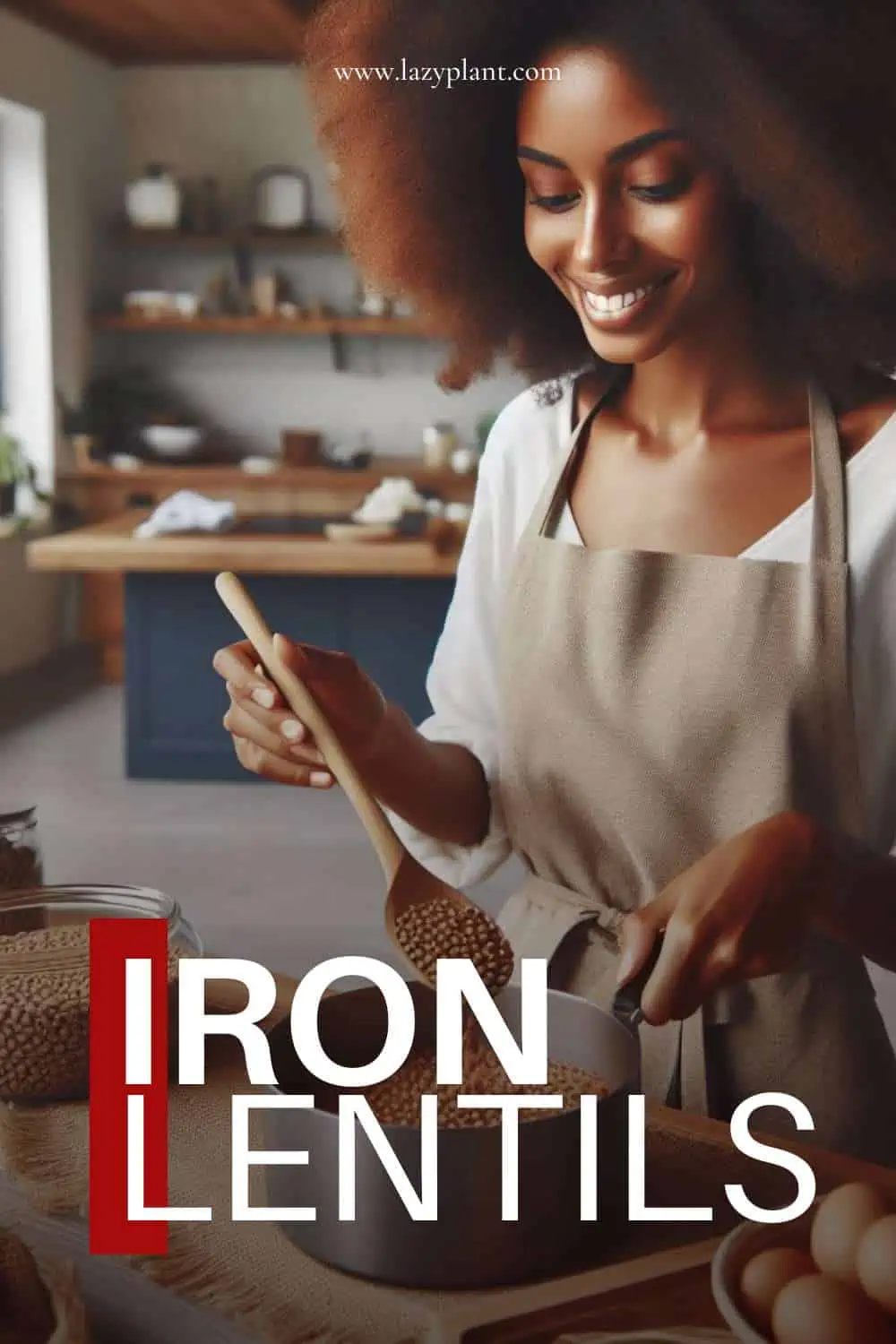
Iron
Lentils are among the best plant-based sources of iron. Cooked lentils contain 3.3 mg of iron per 100g. A serving contains 6.6 mg of iron, which is 37% of the recommended daily intake!
Actually, all beans and legumes are excellent dietary sources of iron. Lentils are the richest bean in iron, second only to soybeans and white beans.
The main categories of lentils are brown, green, red, yellow, black beluga, and Puy. Brown lentils are the most common variety.[11]
Black beluga and Puy lentils are tiny black lentils. They’re 1/3 of the size of brown or green lentils. Puy lentils are grown in the volcanic soil of a region in central France called Le Puy.
All common lentil varieties have a similar iron content. Only beluga lentils are slightly richer in iron. They may have approximately 8% more iron than other lentil varieties.
Moreover, beluga lentils are richer in antioxidant compounds than other common varieties. They’re particularly high in phenolics.[12]
Iron is vital for Health
It’s a key component of hemoglobin; a protein of red blood cells that transfers oxygen from the lungs to the tissues.
Also, iron is essential for muscle metabolism, healthy connective tissue, energy metabolism, cellular functioning, physical growth, neurological development, and the synthesis of some hormones, amino acids, and collagen.[1,2]
Iron deficiency is the most common nutritional deficiency worldwide, though! It may lead to serious side effects, such as gastrointestinal disturbances, impaired cognition, weakened immune function, fatigue, and low body temperature. Moreover, iron deficiency during pregnancy may increase the risk of premature delivery, and miscarriage.[13]
You’ll find a wide variety of iron supplements on iHerb.
Do we absorb the iron of lentils?
Although lentils are pretty rich in iron, we absorb only a small percentage of it. The iron bioavailability of lentils is low. We absorb about 2.2% of the iron in lentils.[14]
However, the absorption rate depends on many factors. For instance, people who are deficient in iron absorb much more iron than people with healthy levels.
How to increase iron absorption?
Lentils have low iron bioavailability due to their high phytate concentrations. They have significant amounts of many other anti-nutrient compounds, like tannic acid, and polyphenols as well. These compounds inhibit the absorption of minerals, like iron.[15]
A simple way to increase the absorption of iron in lentils is to soak and rinse them. Soaking and rinsing of beans reduce the concentrations of the compounds that inhibit iron absorption.
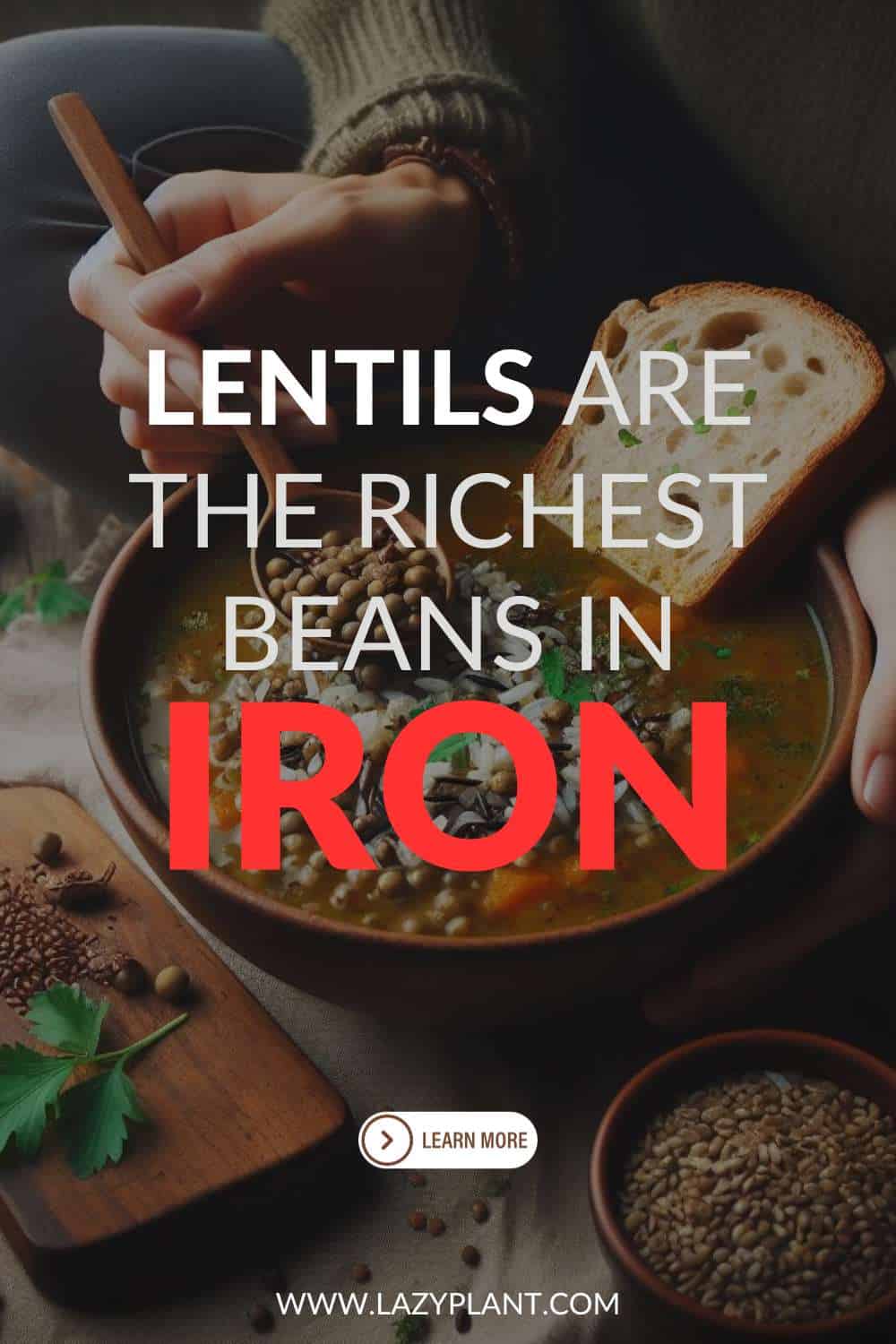
Other beans high in iron are chickpeas. Soaking can increase their iron absorption up to 2.6-fold.
Furthermore, we could increase the absorption of iron by eating plenty of foods high in vitamin C. Vitamin C enhances iron absorption!
Animal-based foods, like meat, poultry, and seafood, also enhance iron absorption.
Moreover, high amounts of calcium might reduce the bioavailability of iron. Hence, better to avoid consuming too much milk and dairy with foods containing iron.
Do Lentils help me Sleep at Night?
Short sleep duration, insomnia, or other sleep disorders have been linked to increased risk of weight gain, diabetes, and cardiovascular disease.[16]
Sleep quality and duration may affect appetite hormones. If we don’t sleep well at night, we have lower levels of leptin (a satiety signal) and high levels of ghrelin (an appetite stimulant)!
Therefore, a bad night’s sleep can lead to overeating, and eventually to obesity.
Actually, eating lentils at night is good for weight loss because they manage appetite and reduce cravings for fattening foods.
Magnesium in lentils can improve sleep quality. It’s a natural muscle relaxant. Adequate amounts have beneficial effects on sleep onset latency, early morning awakening, snoring, sleep duration, and daytime falling asleep. A cup of cooked lentils provides 17% DV.[17,18]
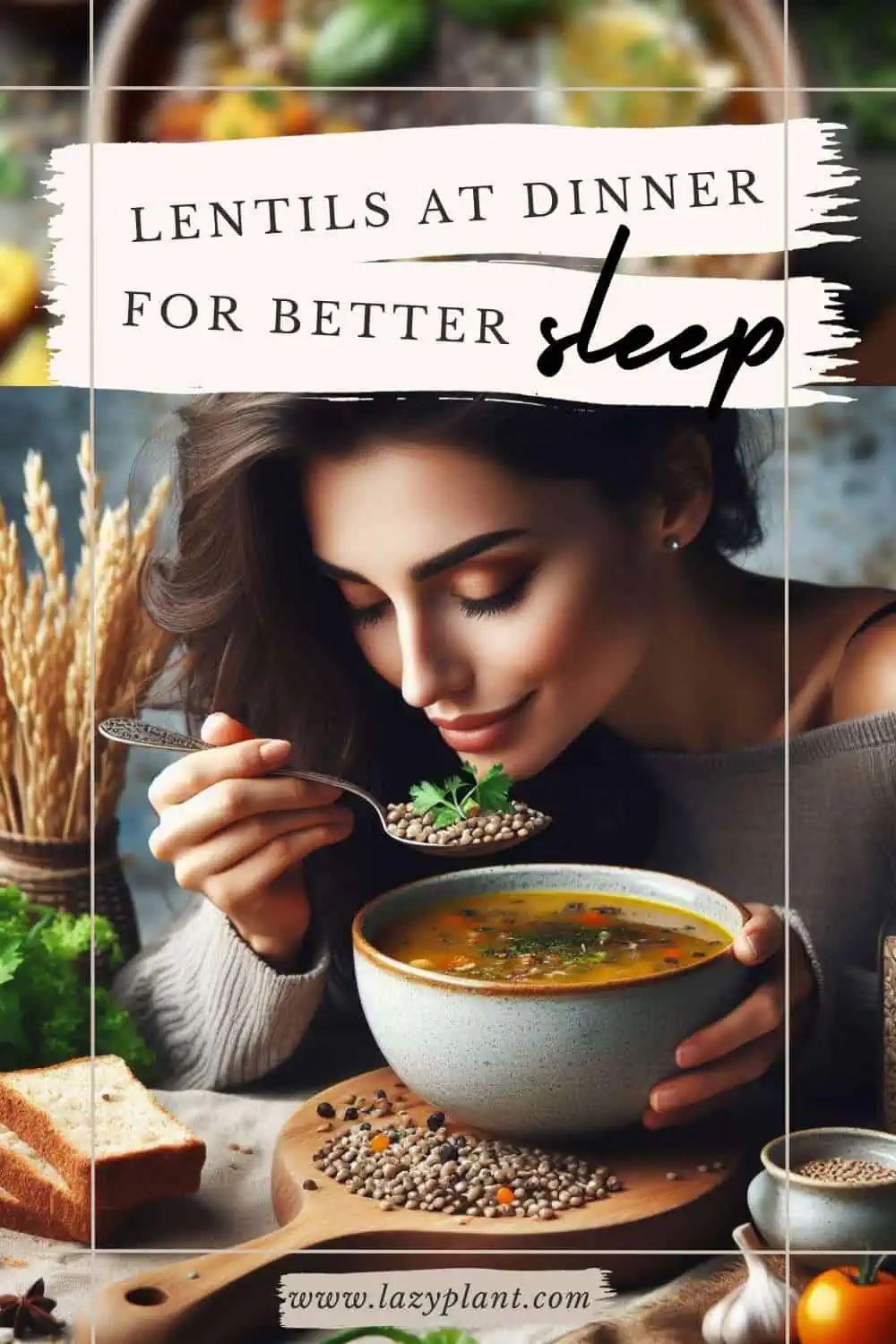
Melatonin is known as the sleep hormone. It regulates night sleep. Thus, eating foods high in melatonin before bed supports a good night’s sleep. Melatonin is synthesized from tryptophan, an essential dietary amino acid, which is found abundant in lentils.
Although raw lentils aren’t rich in melatonin, they have other nutrients that may be involved in its synthesis. Folate, vitamin B6, magnesium, zinc, and polyunsaturated fatty acids (PUFA) may be important for the synthesis of melatonin. Further studies are needed, though.[19]
Lentils are among the richest foods in folate. A serving provides almost 90% of the recommended daily intake. In addition, folate is good for weight loss!
Potassium in lentils (21% DV) may also improve sleep quality.[20,21]
Iron deficiency is associated with sleep disorders. Thus, high iron intake may have beneficial effects on restless legs syndrome, general sleep disturbances, and sleep-disordered breathing.[22]
Tip
Sprouted lentils contain up to 2,000-fold more melatonin than raw lentils. Sprouted lentils contain about 100 mcg of melatonin per 100g, while raw lentils contain negligible amounts.[23]
What if I eat more than a cup a day?
Eating large portions of lentils without considering overall calorie intake may contribute to consuming more calories than needed, leading to weight gain over time. But this is highly unlikely. Most people will feel bloated before overconsuming lentils.
When do Lentils cause Weight Gain?
Lentils won’t make you fat. Even eating more than a cup of lentils per day isn’t fattening.
However, preparing lentils with high-calorie ingredients such as oils, fats, or creamy sauces can increase the overall calorie content of the meal, potentially leading to weight gain.
Meals high in fat are very fattening. Firstly, fat doesn’t promote satiety. Moreover, fat has the highest calorie content. A gram has 9 calories, while a gram of protein or carbohydrate has only 4 calories!
Avoid lentil recipes with added fat
Cooking method is important when trying to cut out calories. For instance, cooking lentils in excessive oil or deep-frying them can significantly increase the calorie and fat content of the dish.
Vegetable oils are the most calorie-dense foods. They’re almost 100% fat. Just a tbsp of any vegetable oil contains about 125 calories.
So, avoid cooking lentils with too much vegetable oil if you want to lose weight. 2 tablespoons have more calories than a cup of cooked lentils!

Adding high-fat creamy sauces, such as those made with heavy cream or full-fat coconut milk, can contribute to a higher calorie and fat intake as well.
Incorporating large amounts of butter, cheese, or ghee into lentil dishes can also increase the overall fat content.
High-fat processed meats, such as sausages or bacon, are high in fat as well. Use them in small amounts if you insist on consuming them.
Added sugar may increase the total calorie content
Using added sugar to lentil dishes is also bad for weight loss. Sweetening lentil dishes with sugar or sugary sauces can contribute to extra calories.
Avoid consuming refined lentil products, such as lentil flour with added sugars. They can contribute to higher calorie intake as well.
Eating too much bread is fattening
Moreover, if you don’t want to gain weight, avoid excess consumption of bread. Eating more than 2 slices of bread per day can make you fat. You should be very cautious with bread portions. It’s easy to overconsume it.
How to Cook Lentils?
Cooking lentils properly can help preserve their protein content and make the protein more bioavailable.
Start by rinsing the lentils under cold running water. Check for any debris or small stones and remove them. While lentils don’t require soaking like some other legumes, you can choose to soak them for a few hours to reduce cooking time and improve digestibility. Drain and rinse before cooking.
Use the right water-to-lentil ratio. Generally, a 2:1 ratio (water to lentils) works well. Adjust based on the type of lentils you’re using.
Avoid adding salt to the lentils at the beginning of cooking, as it can toughen the lentil skins. Add salt only when the lentils are almost tender.

Lentils cook relatively quickly compared to other legumes. Overcooking can lead to a mushy texture and nutrient loss. Cook until they are tender but still hold their shape.
Simmer lentils over low to medium heat to prevent excessive boiling, which can break down the protein structure.
If your recipe includes acidic ingredients like tomatoes or vinegar, add them towards the end of cooking. Acidic environments can slow down the softening of lentils.
Add flavor with aromatic vegetables like onions, garlic, and herbs. This enhances the taste without compromising the protein quality.
Sprouting lentils before cooking can increase nutrient availability, including protein. Sprouting reduces anti-nutrients and enhances digestibility.
Mistakes that make you gain weight
Unbalanced diet
Relying solely on lentils for a majority of your caloric intake may result in an imbalanced diet. A variety of foods from different food groups is essential for overall health and maintaining a normal body weight long-term.
The timing of meal matters
There isn’t a specific “worst’ or “best” time of the day to eat lentils for weight loss. The timing of meals is often a matter of personal preference and lifestyle.
However, some people may find that consuming a large, heavy meal close to bedtime can lead to discomfort, indigestion, or disrupted sleep. In such cases, it might be preferable to eat lentils at lunch or several hours before bed.
A light dinner is preferable for a good night’s sleep which is necessary for burning belly fat and building a leaner body.
Cook lentils with fiber-rich vegetables
Omitting fiber-rich vegetables from lentil dishes may impact satiety and overall meal satisfaction. Also, including a variety of vegetables with lentils can result in a less balanced and nutrient-dense meal.
Healthy soups can be calorie-dense
Consuming lentil-based soups with high-calorie broths or creamy bases can contribute to excess calorie intake.
Who should avoid the consumption of lentils?
While lentils are a nutritious and versatile food, certain groups of people may need to exercise caution or limit their consumption.
People with digestive issues, such as irritable bowel syndrome (IBS) or other gastrointestinal conditions, may experience discomfort with certain types of legumes, including lentils. Proper preparation methods, like soaking and cooking, may help alleviate digestive issues.
Moreover, lentils contain purines, which are substances that can be broken down into uric acid. Individuals with gout may need to moderate their purine intake, and this includes being mindful of legume consumption.
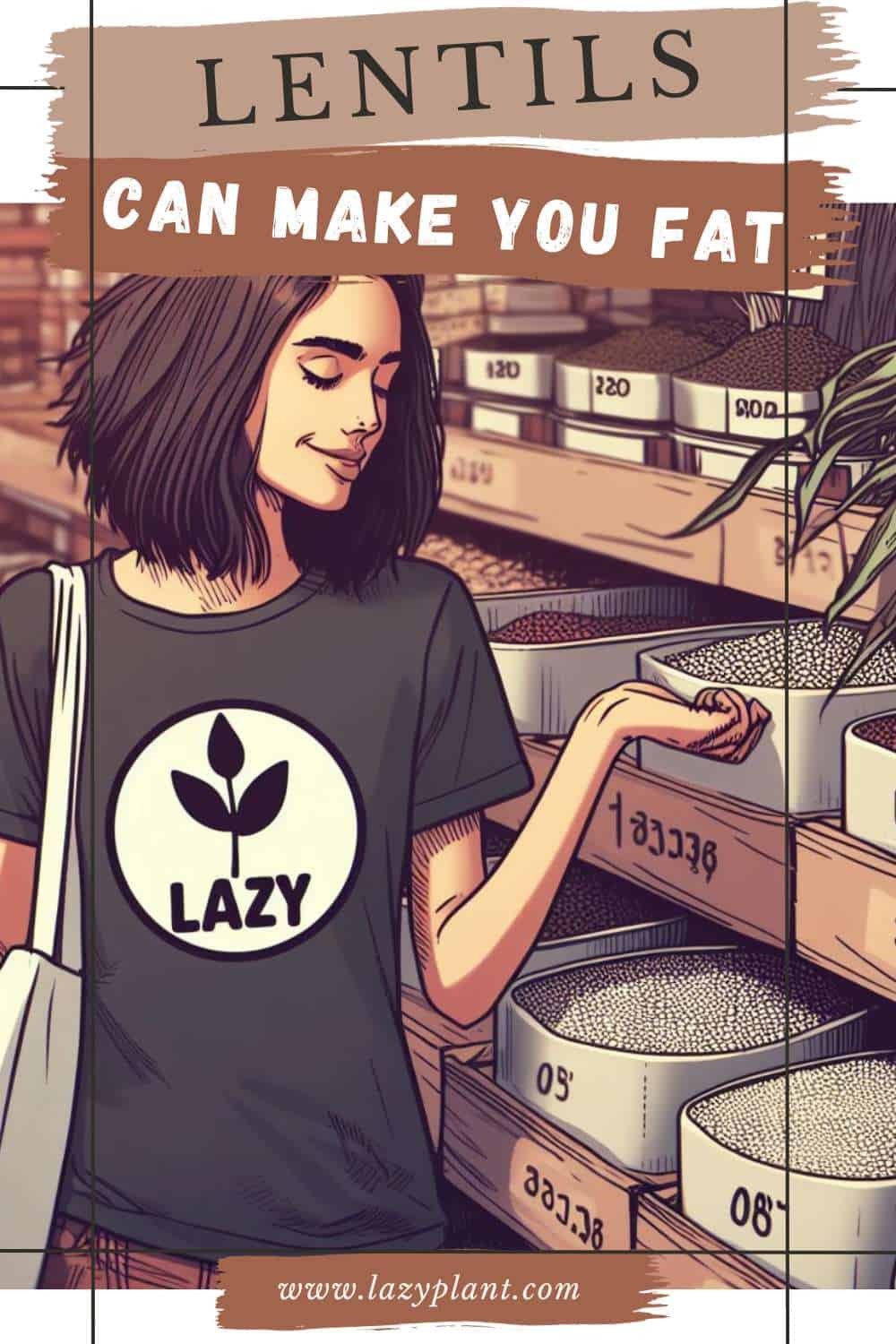
In addition, people who take supplements with folic acid should be very mindful of consuming high amounts of lentils, as they’re among the richest foods in folate. In fact, just a serving provides 90% of the daily value!
Although maintaining healthy levels of folate is beneficial for weight loss, extremely high dosages may contribute to many adverse effects, including weight gain. Too much folic acid may cause fat accumulation or inflammation.
Also, individuals taking medications that interact with nutrients found in lentils (e.g. folate, vitamin K, iron) may need to monitor their intake.
While rare, some individuals may be allergic to legumes, including lentils. Allergic reactions can range from mild to severe, so those with known legume allergies should avoid lentils.
Recipes
Traditional Mediterranean Dishes
These recipes reflect the traditional Mediterranean reliance on lentils as a source of protein and nutrients, often combined with vegetables, olive oil, and herbs to create simple, flavorful, and healthy dishes:
Greek Lentil Soup (Fakes Soupa)
This simple and nutritious soup has been a staple in Greek households for generations. Lentils are simmered with onions, garlic, and bay leaves, then finished with olive oil and vinegar for a tangy, hearty meal.
Italian Lentil Stew (Zuppa di Lenticchie)
A rustic Italian stew where lentils are cooked with vegetables and herbs, often served with crusty bread. It’s a warming dish, rich in fiber and nutrients, often eaten during winter.
Lebanese Lentil Salad (Salatet Adas)
A refreshing and healthy salad made with cooked lentils and fresh vegetables, dressed with lemon juice and olive oil. This dish is light yet filling, perfect for warm Mediterranean climates.
Spanish Lentil Stew (Lentejas a la Riojana)
A traditional Spanish dish from the region of La Rioja. Lentils are slow-cooked with vegetables and paprika for flavor, and often include chorizo for a rich, smoky taste.

Egyptian Lentils with Rice (Mujaddara)
An ancient Middle Eastern dish where lentils and rice are cooked together and topped with caramelized onions. It’s simple but very satisfying, providing both protein and carbohydrates.
Moroccan Lentil and Vegetable Tagine
A hearty Moroccan stew made with lentils and a variety of vegetables, seasoned with warming spices. Often served with couscous or bread, it’s a perfect winter dish.
Turkish Lentil Patties (Mercimek Köftesi)
These savory lentil patties are a popular Turkish snack or appetizer. Red lentils are cooked and mixed with bulgur, herbs, and spices, then shaped into small patties.
Cypriot Lentil and Spinach Stew (Fakes Moutzendra)
A Cypriot variation where lentils are stewed with spinach, olive oil, and lemon juice, creating a nutritious, tangy dish often served with bread.
Modern Recipe Ideas
Here are 7 easy and quick lentil recipes that are nutritious and can support weight loss:
Lentil salad: Toss cooked lentils, cherry tomatoes, cucumber, red onion, feta cheese, olive oil, lemon juice, salt, and pepper together and dress with olive oil and lemon juice.
Red lentil soup: Cook lentils and vegetables in broth, season with spices, and blend for a smooth soup. You can use red lentils, carrots, celery, onion, garlic, vegetable broth, cumin, coriander, turmeric, salt, and pepper.
Mediterranean lentil wrap: Assemble cooked lentils, whole-grain wrap, cherry tomatoes, cucumber, red onion, and feta cheese in a wrap, drizzle with your favorite sauce, and roll it up.
Lentil stir-fry: Sauté vegetables with garlic and ginger, add lentils, and toss with soy sauce. Keep in mind that you should be very careful with the amount of used oil.
Lentil and quinoa bowl: Assemble cooked lentils, cooked quinoa, mixed greens, cherry tomatoes, cucumber, feta cheese, and balsamic vinaigrette in a bowl and drizzle with balsamic vinaigrette.
Lemon garlic lentil pasta: Sauté garlic, add lentils, tomatoes, and spinach, mix with cooked pasta, and drizzle with lemon juice and olive oil.
Lentil patties: Mix cooked lentils, breadcrumbs, egg, parsley, garlic, cumin, coriander, salt, and pepper. Form into patties, and pan-fry until golden brown.
Recipes with in Protein
Lentil and chicken soup: Lentils, chicken, carrots, celery, onions, and chicken broth.
Lentil and shrimp stir-fry: Lentils, shrimp, broccoli, bell peppers, soy sauce, and ginger.
Turkey and lentil meatballs: Lentils, ground turkey, breadcrumbs, and various seasonings.
Lentil and sausage casserole: Lentils, Italian sausage, tomatoes, and cheese baked to perfection.
Lentil and bacon salad: Lentils, crispy bacon, cherry tomatoes, arugula, and a balsamic vinaigrette.
Lentil and tuna wrap: Lentils, canned tuna, mixed greens, and a light dressing in a whole-grain wrap.
Lentil and egg breakfast burrito: Lentils, scrambled eggs, cheese, salsa, and avocado in a burrito.
Lentil and chicken salad: Lentils, shredded chicken, mixed greens, cucumbers, and a light vinaigrette.
Lentil and salmon patties: Lentils, canned salmon, breadcrumbs, and seasonings shaped into patties.
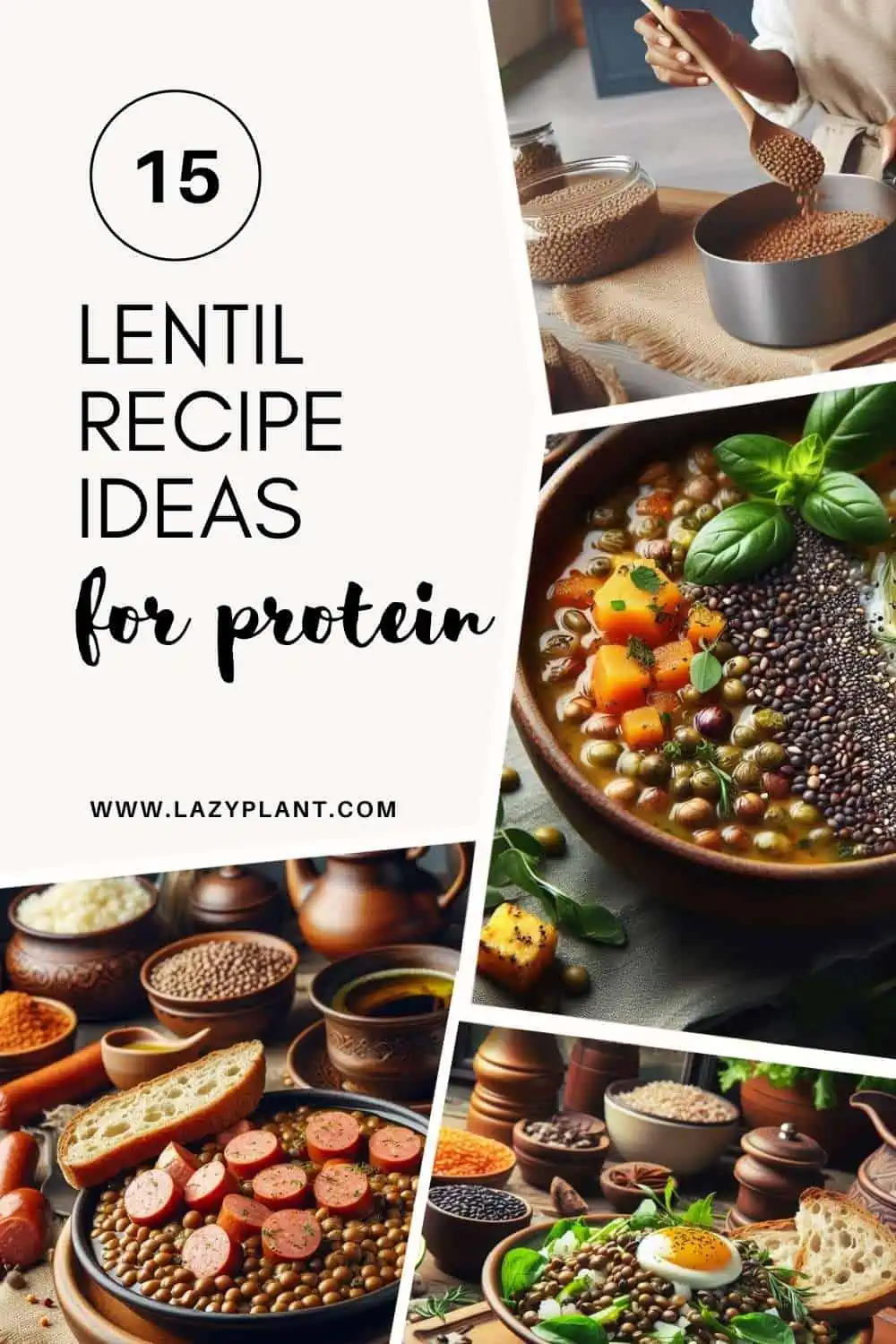
Vegan Recipes
Chia lentil tacos: Lentils cooked with taco seasoning, chia seeds, lettuce, tomatoes, and salsa.
Chia lentil salad: Lentils, mixed greens, cherry tomatoes, cucumbers, chia seeds, and a balsamic vinaigrette.
Lentil and chia seed crackers: Lentil flour, chia seeds, water, and various spices for flavor.
Pumpkin seed and lentil stuffed Bell peppers: Lentils, pumpkin seeds, quinoa, bell peppers, and tomato sauce.
Lentil, sesame, and chia seed wrap: Lentils, sesame seeds, chia seeds, mixed veggies, and a whole-grain wrap.
Sesame lentil stir-fry: Lentils, broccoli, bell peppers, sesame seeds, soy sauce, and ginger.
A serving of favorite lentil snacks or dishes may provide around 15–25 grams of protein, depending on the recipe.